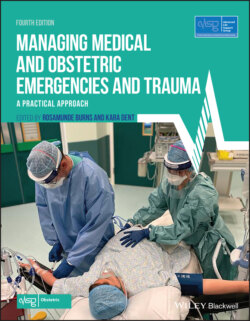Читать книгу Managing Medical and Obstetric Emergencies and Trauma - Группа авторов - Страница 85
5.1 Introduction
ОглавлениеRecurrent themes in mortality and morbidity reports identify that suboptimal care may have contributed to the deaths described in these reports. With more than two thirds of cases having pre‐existing co‐morbidities and indirect deaths exceeding direct, the importance of coordinated care across specialties is emphasised. Failure to recognise symptoms and signs of potentially life‐threatening conditions, delay in acting on findings and delay seeking help from appropriate specialists are all of particular concern. Attention is therefore focused on ways to improve the recognition of, and timely response to, clinical signs of the deteriorating patient.
The diagnosis of a severe life‐threatening condition in a pregnant or recently pregnant woman is challenging when the onset is insidious or atypical. This is compounded by the sick pregnant woman presenting to a non‐obstetric area such as the emergency department where staff are not familiar with pregnancy physiology. The different response to impending critical illness through vital signs can be missed in these circumstances.
Not only ‘high risk’ women become critically ill. Often it is not possible to predict if or when this might happen to any obstetric patient. The relative rarity of life‐threatening events in pregnancy reinforces the need for multiprofessional working and training involving emergency department staff and acute physicians.
The lessons that apply to all health professionals dealing with pregnant women can be summarised as follows:
Understand the physiological adaptations of pregnancy in order to be able to recognise the pathological changes of serious illness – it is important to be able to distinguish between common discomforts of pregnancy and the signs of serious illness so that these signs are not missed (Table 5.1)
Focus on getting things right the first time – high‐quality history taking, physical examination, meticulous recording of basic observations and findings, and acting on those findings without delay
Remember the red flags, including repeated presentation or readmission during pregnancy
Ensuring good communication and timely, effective referrals between professionals
Table 5.1 Physiological changes and normal findings in pregnancy
Source: RCP (Royal College of Physicians). Acute Care Toolkit 15: Managing Acute Medical Problems in Pregnancy. London: RCP, 2019. © Royal College of Physicians
| Indicator | What’s normal in pregnancy? |
|---|---|
| Heart rate | An increase of 10–20 beats per minute, particularly in third trimester |
| Blood pressure | Can decrease by 10–15 mmHg by 20 weeks, but returns to pre‐pregnancy levels by term |
| Respiratory rate (RR) | Unaltered in pregnancy If RR >20 breaths per minute, consider a pathological cause |
| Oxygen saturation | Unchanged throughout pregnancy |
| Temperature | Unchanged throughout pregnancy |
| Full blood count | Ranges altered in pregnancy: Hb (105–140 g/l) WBC (6–16 × 109/l) |
| Renal function | Increased glomerular filtration rate Creatinine falls in first and second trimesters Normal urea reference range 2.5–4.0 mmol/l Normal creatinine <77 μmol/l |
| Liver tests | Raised alkaline phosphatase up to three‐ to fourfold of pre‐pregnancy level is normal during pregnancy |
| Troponin | Not elevated during normal pregnancy May be elevated in pre‐eclampsia, pulmonary embolism, myocarditis, arrhythmias and sepsis |
| D‐dimer | Not recommended for use in pregnancy |
| Creatinine kinase | Normal range 5–40 IU/l, i.e. lower in pregnancy |
| Cholesterol | Up to five times elevated in pregnancy (therefore should not be checked routinely) |
| Thyroid function tests (TFTs) | Use local gestation‐specific ranges |
| ECG | Sinus tachycardia 15° left axis deviation dueto diaphragmatic elevation T wave changes – commonlyT wave inversion in lead III and aVF Non‐specifìc ST changes, e.g. depression, small Q waves |
| Holter monitor | Supraventricular and ventricular ectopics are more common |
| Chest X‐ray (CXR) | Prominent vascular markings, raised diaphragm due to gravid uterus, flattened left hemidiaphragm |
| Peak expiratory flow rate (PEFR) | Unchanged in pregnancy |
| Arterial blood gas | Mild, fully compensated respiratory alkalosis is normal during pregnancy |
